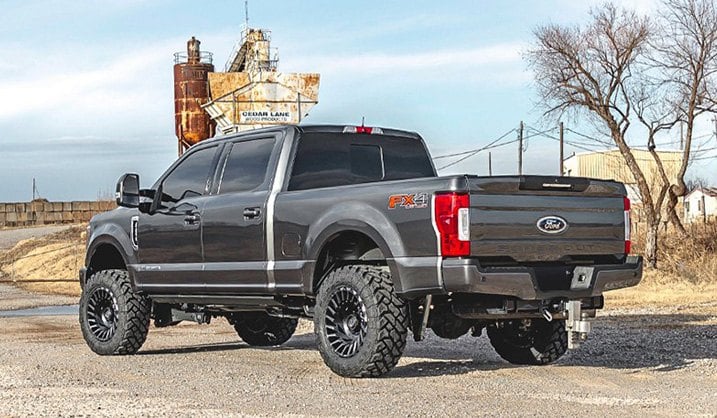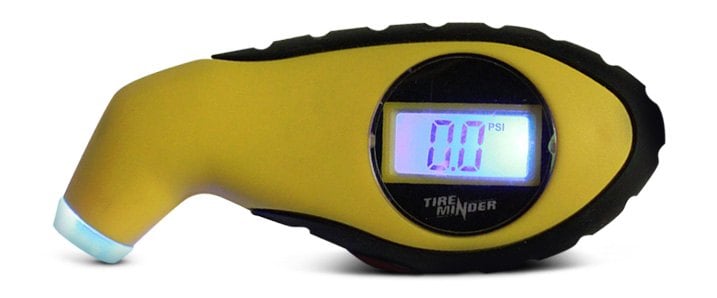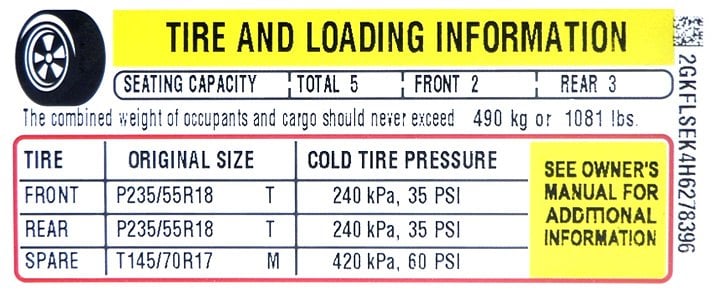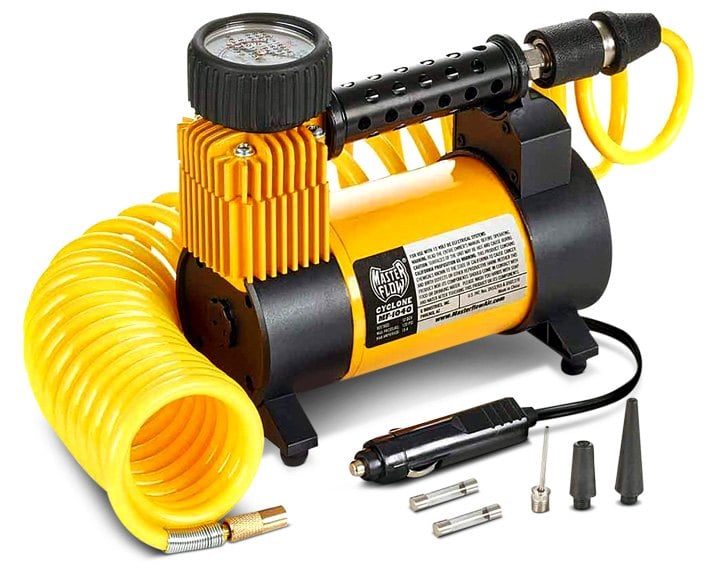A frequent question we get from our customers here at CARiD is, "What can I do to maintain my own car, to avoid paying someone else and to extend the life of my vehicle?" It's a great question, and our staff is always encouraging owners to learn more about their rides to do just that.
Possibly the simplest, most cost-effective, yet valuable maintenance task that any owner can perform is checking and setting the tire pressures on their car or truck. There are a few reasons why this is not done as often as it should: modern wheels and tires are better at holding air; drivers don't own a tire pressure gauge; and if a tire needs air, it means finding a place with a compressor, where compared to the old days, you may be charged for it. It's become too easy to ignore this basic but necessary task.
We're here to tell you that not only is this super-easy, but it will also pay huge dividends in tire life, ride quality, and your own safety! Follow our basic checklist below, and you'll not only be doing your car a huge favor; you can also proudly say that you accomplished something worthwhile for your automobile.
The Importance Of Maintaining Tire Pressure
As Americans drive larger and heavier vehicles, the weight of these vehicles has steadily gone up. It's not unusual for a full-size SUV to weigh 5,000 lbs. (2 1/2 tons) or more. Yet no matter how heavy the vehicle, the only contact between it and the road are the four small contact patches where the tires touch the pavement. These measure only a few square inches, and it is proper tire pressure which maximizes the tires' ability to do their job, allowing the driver to safety steer, accelerate, and brake, all while providing some degree of comfort for the passengers.
Rubber, the principal component of tires, is a natural material, and as such, it always allows some air to escape. Today's technology minimizes that escape but cannot completely eliminate it. Sooner or later, all tires will lose some air pressure. When that happens, the tire's ability to maintain that contact patch diminishes. Tires low on air run hotter, heating the rubber to a point where it could fail and cause a blow-out. In a worst-case scenario, tires which are significantly below their recommended pressure will prevent a driver from performing proper steering or braking maneuvers, compromising the safety of everyone on board.

There are other reasons to make sure that all pressures are up to spec. Tires are expensive, and you should maintain the ones you have to maximize their useful life. Under-inflated tires wear much more rapidly, in some cases diminishing life expectancy by 50% or more. The impact to your wallet is not just the cost of new rubber: fuel mileage is negatively impacted too. Let's say your 5,000 pound barge only gets 20 miles to the gallon; low tire pressures can drop that by 25% or more, and at 12,000 miles a year, this adds an additional $800 in fuel costs (which could pay for your next set of tires!).
Add it all up: longer tire life, better fuel economy, and a safer ride can all be accomplished by simply checking tire pressures on a regular basis. Here's how to do just that.
Purchasing A Tire Pressure Gauge
Start this process by purchasing a tire pressure gauge, and keep it in your vehicle at all times. This way, whether you are home or away, pressures can be checked should the need or desire arise.
You don't need to spend a small fortune on a tire pressure gauge; in fact, we recommend some which will give you change back from a $5 bill. The 'pencil' type gauges, while not necessarily the most accurate, are still good enough for a first gauge. They easily fit in a door pocket or shirt pocket. The Slime brand Pencil Tire Gauge has a range of 5 to 50 PSI (Pounds-per-Squre-Inch), which covers what 99% of cars and light trucks will need. For literally a buck or two more, Performance Tool has one that goes up to 120 PSI and will work for your road bike too.

Dial-type gauges take up slightly more room but are slightly more accurate. This gauge from Professional Products has an advantage over many other dial gauges: a long rubber hose which gives you better access to the valve stem, especially one hidden behind a wheel cover.

Digital gauges are arguably the most accurate, and also potentially the most expensive, with some costing close to $200. However, you can get into a digital gauge for well under $20, starting with either the Big Blue Digital Gauge or the Digital Sport Gauge, both from TireMinder.

Whether you go with one of our recommended choices or find one on your own, the important thing is to keep the gauge somewhere handy so it's there when you need it. If you own more than one vehicle, most gauges are priced affordably enough that you can get one for each.
When And How Often To Check Tire Pressure
How often should you be checking pressure in the tires? And is there a 'right' and 'wrong' way to do it? We acknowledged at the start of this article that this is a simple task which can provide you with a good deal of satisfaction, especially if you're new to performing any kind of vehicular maintenance yourself. But there still are procedures to follow to ensure it's being done correctly.
Generally, it's recommended to check all your tires about once a month. If the tires are older and more likely to lose air, or if you drive more than the average number of miles, they should be checked more frequently. Some fastidious owners check tire pressures with every fuel fill-up. What's important is that you're making the effort on a regular basis.
Is it OK to check them at a rest stop halfway to your summer vacation spot? Absolutely not! It is critical to understand that tire pressures should always be checked when the tires are COLD, meaning, the vehicle has sat long enough for the rubber to be about the same temperature as the ambient air.
Once you're driving down the road, tires heat up quickly; typically, within a few miles. As they heat up from rolling friction, the air inside them also heats up, expands, and increases in pressure. Checking a hot tire will always give an erroneously HIGH reading. Drivers have gotten into trouble by bleeding air out of hot tires, resulting in seriously underinflated tires.
The BEST time to check tire pressures is in the morning, when the car or truck has sat overnight, and before the sun has baked them for half a day. (A non-driven car that has sat in the warm sun will give readings that are 5 to 10 PSI higher than 'cold' tires.)
How To Determine The Correct Tire Pressure
Before you begin checking your tires, it's best to know what the pressures should be. Where do you find this information? By law, all vehicles sold in the U.S. must have a Tire Pressure Label located in an easily-accessed place on the vehicle. Although you may expect this to be in the owner's manual, most manufacturers do NOT list it there, as the owner's manual may cover a wide variety of models, all with different tires and pressures.
The Tire Pressure Label is usually found on the driver's door jamb; for some vehicles it's located on the left rear door jamb, or possibly on the fuel filler door.
The tire label shows 'cold tire pressure' in both PSI and KPA (KiloPascal, a metric unit of measure). Pressures will be listed for 'front', 'rear', and 'spare'. Front and rear pressure recommendations may be different. Some labels list an 'optional' pressure for greater loads or higher speeds. Follow the choice based on your driving situation.
The spare tire pressure shown is almost always significantly higher than for the road tires. Cars built in the last few decades use a temporary spare which relies on higher pressures. Trucks and SUVs are more likely to carry a full-size spare.

The tires' sidewalls also have a 'pressure' indicated on them. This is the tire manufacturer's RECOMMENDED MAXIMUM PRESSURE, which is there to indicate the highest pressure the tire can tolerate. Do NOT use this as a guide when setting your pressures.
How To Make The Actual Pressure Check
You have the gauge, it's early morning, you know what the pressures should be, and you're ready to begin. What do you do?
You can start at any one of the four tires; I find it helpful to begin at the driver's side front tire and circle clockwise, so that I next check the passenger side front; then the passenger side rear; then the driver's side rear. Don't forget the spare! Remove the valve stem cap, and put it where you won't lose it; if they're missing, make a note to buy replacements, as they keep dirt out of the valves.

Press the gauge into the valve stem, keeping it parallel to the stem to minimize pressure loss, and note the reading. What you'll do next depends on whether there is a source of compressed air at your location or not. If there is, it's easiest to add air before moving to the next tire. If there is not, you will want to record all the readings, either by memorizing them or jotting them down if necessary.
How To Add Air To Tires
If there is no compressed air at the location where you've checked your tires, you'll need to move the vehicle to someplace that has it. One issue is that if you're driving more than a mile or so, you'll heat the tires and get a false reading. It's most convenient to have an air source at home. There are portable tire air compressors which are powered though the car's 12V power outlet; The MasterFlow Cyclon Portable Tire Air Compressor and the Nippon America Pipeman 12V Heavy Duty Portable Tire Air Compressor are two of the more affordable models.

You've made note of both the existing and the recommended pressures; you're ready to use compressed air to add air to any tires which read low. Push the air chuck into the valve stem, again aligning it so that you're not letting air out. Add the air only for a few seconds and use the gauge to check. Warning! Tires fill up quickly. Do NOT spend several minutes adding air, or you will dangerously OVERINFLATE the tire. Until you get accustomed to it, add air just a few seconds at a time until your gauge reading matches the recommended pressure.
Should you add a little more air to 'be on the safe side'? In general, no. An overinflated tire is just as dangerous as an underinflated one. The vehicle will not handle or steer as well, it may be more likely to skid on wet pavement, and it will wear out more quickly. Stick to the numbers recommended by the people who built your ride. If you find that the same tire needs air added at every check, have a tire shop check the tire for a slow leak, before it becomes a completely deflated or damaged tire.
A Special Note For TPMS-Equipped Vehicles
All cars and light trucks since model year 2008 have Tire Pressure Monitoring Systems (TPMS) as standard equipment. Although required by law, not every system works the same way. Some will indicate 'low tire' without specifying which; others will specify which tire is low. Even for TPMS-equipped cars, our recommendation stands: check the pressures at least once a month, rather than waiting for the TPMS to indicate an issue. By that time, it may be too late, or you may find yourself in a location too inconvenient to find and add air.
